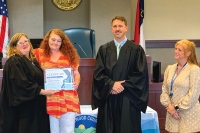No elk allowed: Two-mile fence keeps elk off dairy farm following winter shooting of seven animals

These days, bovines — not elk — are the only cows wandering around the Ross dairy farm in Jonathan Creek.
That’s a first since the elk initially meandered outside the Great Smoky Mountains National Park following their 2001 reintroduction. Located close to Cataloochee Valley, where the elk were released, the Ross farm and its acres of perfect elk habitat quickly became a favorite hangout for the large ungulates as their populations pushed outside park borders.
That preference hasn’t sat well with the Ross family, whose members have become outspoken critics of the elk endeavor and of the herds of 30 to 40 animals that have regularly traversed their property, tearing down fences, eating crops and running the cattle.
No more, thanks to a 2-mile-long stretch of polytape fencing that the N.C. Wildlife Resources Commission installed atop existing fence around the property. The Wildlife Commission paid for the fence, which cost $19,000 for labor and materials, with state money originating from hunting license sales. The Rocky Mountain Elk Foundation reimbursed the organization for $1,900 of the cost.
“It seems to be working really, really well,” said Justin McVey, district biologist for the Wildlife Commission.
No elk have been spotted on the property since.
Related Items
Winter elk deaths in Jonathan Creek
That’s a relief to the Wildlife Commission, because the scene on the Ross farm this winter aroused the ire and consternation of Commission biologists, as well as of many in the general public.
Members of the Ross family shot and killed four elk in January and February, The Smoky Mountain News reported at the time, but documents from a public records request SMN filed afterward revealed that the body count totaled seven. Landowner Ralph Ross declined to comment on the new information or the success of the fencing installed since.
It started the evening of Friday, Jan. 29, when landowner Ralph Ross left a message on McVey’s office phone that he had shot three elk, according to McVey’s written report. McVey and Tanner Baldwin, senior wildlife officer, visited the farm the following Tuesday, after McVey had retrieved the message and was able to contact Ross.
There, they found three elk carcasses lying in the field — a young male, a bull elk and a female calf, according to Baldwin’s written report.
“Both carcasses were in a middle state of decay,” McVey wrote in his report, continuing on to describe that decay in exacting detail.
The following day, Wildlife Commission staff met with Ross and his sons Ferguson and Hank to hear their account of what had happened, according to Baldwin’s report. Ferguson told Baldwin that he had fired the shots from the front of his brother Hank’s home. The elk had been running the cattle around, Ferguson told Baldwin, so he went inside to retrieve his weapon. When he returned, the elk had moved on to grazing the winter wheat crop — the wheat would be harvested in the spring to feed the livestock through the season. He shot one of the elk, but the rest of them stayed put, leading him to shoot two more.
The carnage angered some members of the Commission staff. After hearing the results of Baldwin and McVey’s visit, Brad Howard — private lands coordinator for the Commission — fired off an email underscoring that tension.
“This is getting out of control very quickly,” Howard wrote in a Feb. 2 email to multiple Commission staff members in managerial and supervisory positions. “Our belief is that Mr. Ross is basically ‘spite killing’ for lack of a better description. In my opinion, he needs to provide more evidence that he shot the elk ‘in the act of doing damage;’ elk simply being in his pasture is not doing damage.”
McVey’s report had indicated that he was skeptical that significant damage had occurred.
“I saw no evidence of damage to the wheat, but it was only a few inches high,” McVey wrote. “I did not notice very many hoof prints.”
At the time, the Wildlife Commission was preparing to vote on — and ultimately passed — a rule change that would pave the way for an elk-hunting season in the future. A public hearing on the issue held in January had drawn a couple hundred people and swells of opinion.
“I do not need to tell you how this relates to timing of activities this and next week,” David Cobb, chief of wildlife management for the Commission, replied to Howard’s email. “For the record, I agree with you, unless he can show demonstrable depredation, he should be charged.”
Investigators, however, decided against pressing charges. Instead, Commission staff decided to look for solutions, with McVey and Mark Williams, a conservation technician, heading out to the Ross farm Feb. 12 to consider fencing options to keep the elk out, according to a Feb. 12 email McVey wrote.
As they walked the property, Williams noticed a dead bull elk in the woods, on the other side of the pasture fence, McVey wrote. Williams continued exploring the area and called out that he’d found a buried elk, too.
Further investigation revealed three areas of “freshly disturbed” dirt, according to McVey’s report, with each area exhibiting elk hair on the surface. An elk hoof and lower leg protruded from the ground in one of the areas and McVey found a spot where puddled blood had soaked into the dirt.
“The tracks from machinery led down to Steve Ross’s dairy where there was a front-end loader that looked like it would have made the tracks and been able to bury the animals,” McVey wrote.
Reasons for discrepancy
SMN’s Feb. 17 report that only four elk had been killed on the Ross farm was based on repeated conversations with Wildlife Commission personnel that continued through Feb. 16. But the discovery of public records putting the number at seven speaks more to the pitfalls of remote communication than to intentional deception, multiple Wildlife Commission staff members said in follow-up interviews.
“I don’t think there was ever any deliberate attempt to hide numbers or anything like that,” Howard said. “I think there was just a lot of confusion as to how many had definitely been determined were shot versus ‘We think there might have been.’ I think some people were reluctant to say, ‘It was this.’”
Elk-related issues are inherently hot-button, and when the first dead elk were found on the Ross farm, Wildlife Commission leaders knew that a media storm would follow. They routed all communication on the issue through Raleigh in an effort to control the message. However, at the time the Wildlife Commission’s public information officer was still new to the job and a Wildlife Commission Lieutenant who had never even seen an elk before or set foot on the Ross farm was given the task of fielding media calls.
“I don’t think the individual in Raleigh was intentionally trying to mislead,” Howard said. “I think he was worried he would disclose something he shouldn’t disclose.”
There’s still some anger in the community over the killings. With the total elk population estimated at 150, seven elk represent a significant proportion of that — 4.7 percent.
“To kill three elk, it just kills me,” Brevard resident Robert Hunter said at a public hearing held this month on a different elk issue, referring to the three elk shot Jan. 29. “I killed three elk in my time, but I went to Wyoming to get them and they cost me more than a good beef did, too.”
So far this year, eight elk have been reported dead — seven due to depredation on Ross property and from an unrelated vehicle collision. The number is about equivalent to elk mortality at this time last year. Between January and October 2015, seven elk were reported dead, though only one death was due to depredation. Of the rest, one was euthanized due to disease and five died following car crashes. In total, 15 elk were reported dead in 2015, though only two from depredation.
But, Howard said, when it comes to what happened on the Ross farm, body count isn’t the most important consideration.
“The numbers mattered somewhat less than the extent to which they (the Ross family) were within their right to do it,” he said.
No charges filed
Howard is the first to admit that his emailed reaction to the elk killings was fiery and strongly worded, rather unequivocally stating that the Ross men were probably not within their rights to fire the shots. With more than half a year elapsed since the incident, Howard has a different view. Calling the deaths “spite killing” was “a poor choice of words,” he said.
“That comment was in sheer frustration at the inability to protect the elk, for lack of a better word, because we weren’t sure how to do it,” Howard said. “Ultimately after the full investigation it was a poor choice of words. I think the landowners were as frustrated on one side of the situation as we were on the other.”
Frustration isn’t in short supply when it comes to the elk, said William Carter, who farms land adjacent to the Ross family. His neighbors are good people and hard workers whose livelihood depends on the grass they grow to feed the cows that they milk, he said — he’s confident that they did only what they had to do.
“They took no enjoyment in shooting elk, and if they wanted to shoot elk they could have cleaned house over there,” Carter said.
Investigators concluded that the killings fell within the Ross family’s legal right to kill wildlife caught in the act of damaging property, and no charges were filed.
Despite his initial reaction to the news, Howard said he’s happy with the decision and the progress that’s been made since.
“Ultimately our agency made a decision and we are all behind it,” Howard said. “We decided to really become even more engaged and say, ‘Let’s see how we can work with you guys.’ We’ve never done fencing on that scale, and it’s thus far been successful.”
Mike Carraway, district supervisor for the Wildlife Commission, said he hopes to see that success continue and the Wildlife Commission’s relationship with the Ross family and other farmers in the area grow in its collaborative spirit.
“We’ve worked really hard to try to resolve some of these issues so people can live with elk,” Carraway said. “The Wildlife Resources Commission is working with landowners to try to resolve some of these issues so we don’t get to the point where people are shooting elk anymore.”









